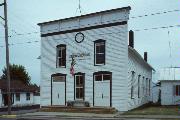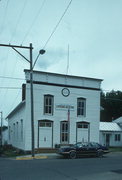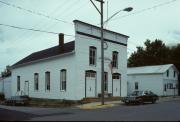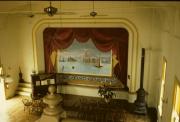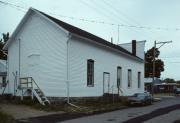| Additional Information: | A 'site file' exists for this property. It contains additional information such as correspondence, newspaper clippings, or historical information. It is a public record and may be viewed in person at the Wisconsin Historical Society, State Historic Preservation Office.
Town halls are the most visible symbol of the Wisconsin system of town government. In many states, the 36-section townships drawn by the federal land survey in the nineteenth century simply delineated a geographical grid. In Wisconsin, however, the state constitution made each of the townships a functioning local government. Indeed, they became the most important political unit for citizens living outside the boundaries of incorporated cities or villages. As local governments provided more and more services, many of these towns replaced their older halls. This one is a rare survivor.
Local carpenter William A. Hocking built the vernacular Italianate structure in 1891 and may well have designed it. Its false front was a common, economical way to make a simple front-gabled building look imposing. Hocking enhanced the clapboard building by adding triangular pediments and crowning the structure with a bracketed parapet wall clad with sheet metal. A round, louvered ventilator pierces the wall just below the parapet. On the ground floor below this bull's-eye, a pedimented window between the two doorways seems oddly placed, but it reflects the building's dual function. The window and the right-hand doorway mark the location of the town clerk’s office, whereas the left-hand doorway opens onto a vestibule leading to the auditorium to the rear.
From its beginning, the town hall also held a so-called “opera house” for theatrical and other community events. This one remains remarkably intact. Notice the tongue-and-groove walls and ceiling, visually supported by oversized, scroll-sawn brackets with walnut pendants. A wooden balcony, whose rail is not original, looks out over the stage. Behind the stage’s proscenium arch, shaped like a basket-handle, hangs a replica of the original canvas drop-curtain, hand-painted with a panoramic view of Venice.
THIS BUILDING IS ARCHITECTURALLY SIGNIFICANT BECAUSE IT IS A VERY GOOD EXAMPLE OF A RURAL PUBLIC BUILDING. IN ADDITION, IT IS IMPORTANT BECAUSE IT HAS BEEN A VISUAL LANDMARK AND CENTER OF ACTIVITY FOR THE TOWN OF HAZEL GREEN SINCE THE 19TH CENTURY.
ACCORDING TO THE INTENSIVE SURVEY FORM, THE BUILDING WAS CONSTRUCTED BETWEEN THE YEARS 1868 AND 1877. |
|---|

